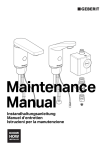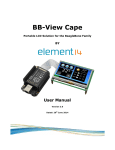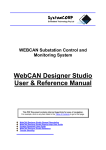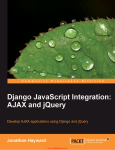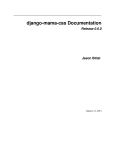Download User define protocol
Transcript
User define protocol User’s Manual Wuxi Xinje Electronic Co.,Ltd. Content 1 2 Introduction.............................................................................................................................................................. 3 Procedure.................................................................................................................................................................. 4 2-1 Have a view of destination device protocol.................................................................................................... 4 2-2 Register and establish protocol file ................................................................................................................ 6 2-3 Program a protocol file..................................................................................................................................... 9 2-3-1 Introduction........................................................................................................................................... 9 2-3-2 Where do program protocol code ? ....................................................................................................... 9 2-3-3 Structure of protocol code ..................................................................................................................... 9 2-3-4 Procedure ............................................................................................................................................ 10 2 1 Introduction ■What is user-define protocol? User-define protocol is a communication protocol programmed by users to support those devices which are not included in device list. ■ Why do we use user-define protocol? As a communication rule, communication protocol is an agreement made by both transmission parties, including data structure, synchronous method, transmission speed, debug method, character define and so on. In other word, the data transmission between panels and device takes effect only when both parties comply with communication rule strictly. As we can see from the Touchwin editing tool, most of the communication protocol for general PLC, inverter and other protocol in market already in the selection list of devices. Deviceslis t If the destination device is not listed in the device list, please check whether the protocol of this device is same as those have existed in the list, such as ‘Modbus’ protocol. In this case , just select the same protocol, otherwise ,program a user-define protocol according to destination device . 3 2 2-1 Procedure Have a view of destination device protocol The following chapters take device V900(a virtual parameter) for example to describe how to program a user-define protocol. Please find out the send and receive data information from the V900 communication protocol. In this example, the parameters including current weight, destination weight and flow, will appear on panels. Address of assignment of V900 Current weight H42 Destination weight H44 Flow H43 Data structure of read registers Request to V900 Station NO. Function code (read registers)03 Starting Address Checksum Response V900 Station NO. High byte Low byte Checksum from Set communication parameters of V900 as follow: Station NO: 1 Baud rate:9600 Even parity Data bit :8 Stop bit:1 There is example of data structure based on V900 1. Read current weight: Request: H01 H03 H42 SUMCHECK Response: H01 Highbyte Lowbyte SUMCHECK 2. Read flow: Request: H01 H03 H43 SUMCHECK Response: H01 Highbyte Lowbyte SUMCHECK 4 3. Read destination weight: Request: H01 H03 H44 sumcheck; Response: H01 Highbyte Lowbyte SUMCHECK 5 2-2 Register and establish protocol file ■ Introduction The purpose of this step is to add new device item named V900 into device list, and establish carrier file for this protocol. ■ Procedure 1.Open the root directory of Touchwin software: 2.Find the custom..dat file and open in notepad format, add item ‘V900=V900 parameter’ in bottom part, save this and close. Please note that the left part of ‘=’ is filename, the right part of ‘=’ is device name existed in device list. Note: please remove the attributes ‘read-only’ or ‘hidden’ if there is a problem in saving operation. 6 3. Open the file ‘Device’ in the root directory and find configuration file ‘Device.ini’ to check following code: [option] Number=n In this example, the quantity of devices is n=41, after adding a new item, now the quantity is n= 41+1= 42 7 4. Please add the following content in the bottom part of ‘Device.ini’ file. [sequence42] filename = V900 Save this change and exit. 5. After this please return to ‘Device’ file and establish a new file named ‘V900’, open this new file and build the following two files. Note: you can build these two new files by copying from other device file , and rename as ‘V900’ 6.。Now, the step of ‘register and establish protocol file’ is finished and you will find the 8 device named ‘V900 parameter is existed in the device list already. 2-3 Program a protocol file 2-3-1 Introduction This chapter will describe how to program protocol code. 2-3-2 Where do program protocol code ? Open ‘V900’file in the ‘Device’ file from root directory to double-click file ‘V900.ini’ file where we program protocol code. 2-3-3 Structure of protocol code AS a communication rule, protocol code consists of following parts: ● File description ● Default communication setting 9 ● Default Station NO ● Object description ● Communication rule ● Object Type optimization 2-3-4 Procedure ● Descript (File description) Please write the following content in ‘V900.ini’file with a standard form, as below: [descript] DeviceModelCode=22 FirmwareName=UserDefine DownLoadDll = \Device\UserDefine\DownLoad.dll SpecInfoDll = \Device\UserDefine\DownLoad.dll DeviceType = 100 ● Communication (Default communication settings) Set the default communication parameters when you select the V900 device: Default Communication Parameter 10 Write the following ‘default communication setting’ code as below: [Communication] BaudRate=9600 ; Baud rate DataBits=8 ; Data bits Parity=2 ; Parity 0-None, 1-Odd, 2-Even StopBits=0 ; Stop bit 0-1 bit, 1-1.5 bits, 2-2 bits ● StationNo (Default station NO) This part is comprised of panel part and device part, code is showed as below: [StationNo] PanelWithStationNo=0 PanelDefaultStationNo= ; 0: station NO of panel is not permitted to set 1:settable [Note 1] ;Default station NO of panel, ‘there is no value because the station NO is not permitted to set in this example’; PanelMinStationNo= ;the minimum Station NO of panel. ‘there is no value because the station NO is not permitted to set in this example’; PanelMaxStationNo= ;The maximum Station NO of panel . ‘there is no value because the station NO is not permitted to set in this example’; DeviceWithStationNo=1 ; 0: station NO of device is not permitted to set 1: settable [Note 1] DeviceDefaultStationNo=1 ; Default station NO of device with 1 DeviceMinStationNo=0 ; The minimum Station NO of device DeviceMaxStationNo=255 ; The maximum Station NO of device NOTE 1 Notation: As a slave in communication system, the station NO of panel is settable with setting PanelWithStationNo=1 as showed in the device list; when PanelWithStationNo=0, the settable information is not eyeable. 11 ● Object (Object description) This chapter takes example to describe how to write code for object description. If we need to read the current weight of V900 device, we should define the occupied spaces and communication rule. [Object] ObjectNum=13 ; Numbers of objects [Object1] ; The first object CanAct=1 ; Space unit occupied by objects, 0- bit; 1-register; 2-register group [Note 1] IDSymbol= Current Weight ; Item name lied in software [Note 2] TypeNo=0 ; Corresponding ‘Object Type optimization’ NO. bitlength = 16 ; ‘current weight’ occupies 16 bits DescripNum=1 ; Section No. of object description [Note 3] CanSelectType=4 ; Data type selection:(0000 0100);5-3 bytes,4-n Regs,3-dword, 2-word,1-byte,0-bit【Note 4】 ReadWord = 1 ; Called communication rule No. of ‘read register’ [Object1Descrip1] ; Object description Section 1 Caption= ; standard form Type=0 ; Type of digital input in software 0-Number,1-(0-7),2-(00-07),3-(0-15),4-(00-15), 5-(0-F),6-(00-0F),7-(0-31) 【Note 5】 12 DefaultNumber=0 MinNumber=0 MaxNumber=0 format=10 NumberStep=1 ; Default value of digital input in software ; Min number of digital input in software ; Max number of digital input in software ; Data format of digital input in software ; Standard format 13 Notation : 【Note 1】 :This item is used to define the object type that this item belongs to: bit, register or registers. When we select with Bit, this means the object name will appear on bit component like ‘lamp button’; when we select with register, this means the object name will appear on word component like ‘digital input, digital display’; when we select registers, that means object name will appear on registers components like ‘character input’. 【Note 2】 :Component will contains items--‘current weight’, as below: 【Note 3】: Section No. of object description, we set with ‘1’ in this example which means there is only one description value with this object type, as above. But it is noted that there are two description values for some object type in some protocol. For example, we can see that the object type D in Omron PLC protocol consists of two sections, like D100B is comprised of 100 which is in Decimalist format and B which is in range from 0 to F,thus we can proram code as follows (note : A part is code for 100, B part is code for B): [Object9] CanAct=0 IDSymbol=D TypeNo=0 bitlength = 16 14 DescripNum=2 CanSelectType=1 ReadBit=16 SetBitOn=23 SetBitOff=23 [Object9Descrip1] A part Caption= Type=0 DefaultNumber=0 MinNumber=0 MaxNumber=99999 format=10 NumberStep=1 [Object9Descrip2] Caption=. Type=3 DefaultNumber=0 ; B part Description1 Description2 【Note 4】: Define data type which is comprised of 8 bits in binary system: Bit 7 6 5 4 3 2 1 0 1 - - 3 bytes n Regs dword word byte bit 0 - - - - - - - - If we need option both word and Dword, we can have value 00001100 , in decimalist form is 12, thus we can write code CanSelectType=12, as follow: 15 【Note 5】 : Type of digital input in software Standard Value. Type of digital input 0 0~ the maximum value 1 (0-7) 2 (00-07) 3 (0-15) 4 (00-15) 5 (0-F) 6 (00-0F) 7 (0-31) When we select standard value with 5 , the display in software is showed as below: 16 ● CommuRule (Communication rule) This chapter describes the data structure of request as a hardcore of a protocol. [CommuRule] CommuRuleNum = 19 ; Numbers of communication rule IsUseASC = 0 ; Use ASC format or not 0:No use ASC, 1: use ASC as Transmit Data LowBitToASC = 0 ; Ignore high bit or not ? 0:NO, 1:YES 【Note 1】 IsHightBitNext = 0 ; Based on ASC convert, is high bit or low bit in the first 0:NO, 1:YES 【Note2】 IsHightByteNext = 0 ; Take word as basic unit, is high byte in the first position? 0:No, 1:YES IsHightWordNext = 0 ; Take Dword as basic unit, is high word in the first position? 0:NO, 1:YES [CommuRule1] IsInherit = 0 GroupNum = 2 ; This communication rule is inherit or base? base=0 inherit=1 【Note 3】 ; Group Number of data transmission, set this value with 2 because the data transmission consists of two steps: request and response. Group1Type= 0 ; Group 1 is defined as data request Group1Blocks = 4 ; Block quantity of group 1 is 4 Group2Type = 1 ; Group 2 is defined as data response Group2Blocks = 3 ; Block quantity of Group 2 is 3 Group1Block1 = 4 ; The 1st block of group1: Station No. of device 【Note 4】 nd Group1Block2 = 5 ; The 2 block of group1: Function code. 【Note 4】 Group1Block2_CmdNo = 3 Group1Block3 = 1 ; the 3rd block of group1: Static data 【Note 4】 Group1Block3_StaticValue = 0x42 ; Group1Block4 = 11 ; The 4th block of group1: check 【Note 4】 Group1Block4_StartBlock = 1 Group1Block4_EndBlock = 3 Group1Block4_SelectMethod = 1 Group2Block1 = 4 ; The 1st block of group2: 【Note 4】 nd Group2Block2 = 10 ; The 2 block of group2: data 【Note 4】 Group2Block2_DataAreaType = 1 Group2Block3 = 11 ; The 3rd block of group2: check 【Note 4】 Group2Block3_StartBlock = 1 Group2Block3_EndBlock = 2 Group2Block3_SelectMethod = 1 [CommuRule2] IsInherit = 1 InheritRule = 1 ; This communication rule is inherit or base? base=0 ; Where does this communication rule inherit from? ; Enumerate the block need to redefine Group1Block3 =1 Group1Block3_StaticValue = 0x44 inherit=1 17 Notation 【Note1】: There is an example for how to interpret this code, for example, after converting to ASC format ,0x56 becomes 0x35,0x36 , if we set this with LowBitToASC = 0, so the code 0x56 becomes 0x36 . 【Note2】: There is an example for how to interpret this code, for example, after converting to ASC format,0x56 becomes 0x35,0x36, if we set with IsHightBitNext = 1, so the code 0x56 becomes 0x36,0x35. 【Note3】 Base: define each block of communication rule. Inherit: only to enumerate the block need to redefine when the communication rule is similar to any base communication rule. 【Note4】: Nearly all transmission data structure consists of these parts: station No, function code, data content, data quantity, check sum. And how about the description in Twin user-define protocol, there is an example: Group1Block4 = 11 Group1Block4_StartBlock = 1 Group1Block4_EndBlock = 3 Group1Block4_SelectMethod = 1 As above, we can see that Group1Block4 = 11 defines the function of Group1Block4, ‘11’ is the code name which means check sum. And Group1Block4_StartBlock , Group1Block4_EndBlock , Group1Block4_SelectMetho are the extended definition of Group1Block4, Thus, each block is comprised of function definition and extended definition, for some simple function ,there only need to define function, such as Group1Block1 = 4 The following chapter describes the details of code name of function definition(X: group No, Y: block No.): Code name of function definition 1 Meaning Static data: use in the case that block value is defined Extended definition Group X Block Y _StaticValue Code name of function definition Meanings Extended definition 2 Block length:Bytes length from starting block to end block. Group X Block Y _LowBitToASC Only remain low bit after ASC conversion. For example, 0x56 ASC Convert to 0x35, 0x36 , after pass through LowBitToASC , left 0x36. 18 Group X Block Y _StartBlock Start Block number, this block is included in count. Group X Block Y _EndBlock End Block number, this block is included in count. 4 Code name of function definition Meanings Extended definition Station No.: define the device station No. Group X Block Y _LowBitToASC 5 Code name of function definition Meanings Extended definition Command code: define code for ‘write’ or ‘read ’operation. Group X Block Y _LowBitToASC Only remain the low bit after ASC conversion. Group X Block Y _CmdNo Take Modbus for example, we use function code 3 for ‘read holding registers’, so it is expressed as Group X Block Y _CmdNo=3 7 Code name of function definition Meanings Only remain the low bit after ASC conversion. Parameter address: example, we need to set object with D1000 if we want to read the value of D1000,thus ,1000 is taken as parameter address, as below: When parameter in software is set as 1000, after converting to hexadecimal format, it becomes 03 E8. When parameter in software is set as 1000, after converting to ASC ,it becomes 31 30 30 30. Extended definition Parameter address convert to hexadecimal format Group X Block Y _ DispMode=0 Mode selection(DispMode=0, convert address to hexadecimal format) Group X Block Y _LowBitToASC Only remain low bit 19 after ASC conversion Group X Block Y_IsHightByteNext For word, high byte in the first position with low byte followed Group X BlockY _IsHightWordNext For Dword, high word in the first position with low word followed. Group X Block Y _ ParaAddress Expression of address conversion The reason why we need expression of address conversion is that the parameter address face to users is different with the ones in data transmission, such as Xinje PLC: the address face to user is TD0, but in transmission process it is H3000, so we need a expression to describe the relation between them. As we can see that ,the address in transmission data in TD N is N+0x3000, thus the expression is Block Y_ParaAddress = N+0x3000. Parameter address convert to ASC format Group X Block Y _HoldSpaceSize (1:Byte;2:Word; 3:DWord)which means space size, for example , Group X BlockY_HoldSpaceSize =2 defines a word size. Group X Block Y _ DispMode = 1 Mode selection(DispMode=1 convert address to ASC format) Group X Block Y _LowBitToASC Only remain low bit after ASC conversion Group X Block Y_IsHightByteNext For word, high byte in the first position with low byte followed Group X BlockY _IsHightWordNext For Dword, high word in the first position with low word followed. Group X Block Y _FormatLen space size with unit Byte. (0:No need;1:Need) Need 0 lead or not Group X Block Y _NeedPreZero Group X Block Y _ ParaAddress Expression of address conversion 20 Code name of function definition 8 Meanings Numbers of parameters: the numbers of parameters to operate. Sometime it needs to operate several continuous parameters in one transmission data to improve efficiency. Extended definition Group X Block Y _LowBitToASC Only remain low bit after ASC conversion Group X Block Y_IsHightByteNext For word, high byte in the first position with low byte followed Group X BlockY _IsHightWordNext For Dword, high word in the first position with low word followed. Group X Block Y _HoldSpaceSize which means space size, for example , Group X BlockY_HoldSpaceSize=2 Group X Block Y _CountMethod defines a word size. (1:BITS;2:BYTES;3:WORDS; 4:DWORDS) Code name of function definition: 10, which describes the data area, the structure is showed as below: 21 Code name of function definition 10 Meaning s Data area: save space for transmit data. For example, if we want write 100 into register D100, thus value 100 is the destination to be saved, meanwhile , this area also save the read data. Extended definition Group X Block Y _LowBitToASC Only remain low bit after ASC conversion Group X Block Y_IsHightByteNext For word, high byte in the first position with low byte followed. Group X BlockY _IsHightWordNext For Dword, high word in the first position with low word followed. (1:byte;2:word;3:dword) Group X BlockY _HoldSpaceSize= (2,3,4) Take effect Group X BlockY _DataAreaLenType Group X BlockY _BitStatus Group X BlockY _HoldSpaceSize= 2 Take effect, the read bit value Group X BlockY _SetOnValue Group X BlockY_DataAreaType= 3 take effect Group X BlockY _SetOffValue Group X BlockY_DataAreaType= 4 take effect Group X BlockY _DataAreaSubType Group X BlockY_DataAreaType= 5 take effect Group X BlockY _OnValue Group X BlockY_DataAreaType= 5 Group X BlockY _DataAreaSubType=1 22 Take effect The status seems ON when the corresponding Byte is equal to ‘OnValue’ Group X BlockY _OffValue Group X BlockY _DataSubType Group X BlockY_DataAreaType= 5 Group X BlockY _DataAreaSubType=1 take effect (0:Dec 1:Unsigned 2:Hex) Group X BlockY_DataAreaType= 6 take effect Group X BlockY _FormatLen Formatlenn describes the Max.length of formatting Group X BlockY_DataAreaType= 6 Group X BlockY _DataSubType=(0,1,2) take effect Note: Formatlen describes the Max. length of formattin, but when the value is set as ‘0’, it means the data length adjusts automatically, and NeedPreZero is not available. Group X BlockY _NeedPreZero Group X BlockY _FormatTpye (0:No need;1:Need) Group X BlockY_DataAreaType= 6 Group X BlockY _DataSubType=(0,1,2)take effect (0:expressed in ‘dddd.dddd’ format ) Group X BlockY_DataAreaType= 6 Group X BlockY _DataSubType= 3 take effect Group X BlockY _Precision precision of decimal Group X BlockY_DataAreaType= 6 Group X BlockY _DataSubType= 3 take effect Group X BlockY _ModNumber data shift Group X BlockY _DataAreaType=5 Group X BlockY _DataAreaSubType=2 take effect GroupXBlockY _DataAreaType: This parameter defines the data area type for saving data: Bit, Byte, Word or other type. Value GroupXBlo ckY_DataA reaType Meanings 1 Read/write register/regi sters 2 Read single Bit Description Read the needful Bit status from response data word or byte. There, we take the Xinje V5series inverter for example to read the rotation direction. The address of rotation direction is H2101, the 23 third bit indicates the status of direction: value ‘0’ shows forward, value ‘1’shows reverse , code is programmed as follow: [CommuRule12] ;read status of direction IsInherit = 1 InheritRule = 1 Group1Block3 = 7 Group1Block3_HoldSpaceSize = 2 Group1Block3_ParaAddress = N+0x2101 Group2Block4 = 10 Group2Block4_DataAreaType = 2 Group2Block4_DataAreaLenType = 2 Group2Block4_BitStatus = P & (1<<2) Please note the red part, we already get value from H2101, but how to get the status of the third Bit? Group2Block4_BitStatus = P & (1<<2) We use character P stand for the value of H2101; and the (1<<2)means left shift two bits to 0000 0001, then it becomes 0000 0100, after that , do the ‘and ’operation to P and 0000 0100, thus, we get the third bit value. If P & (1<<2)=0, the status is OFF, If P & (1<<2)=not 0, the status is ON, 【 More details regarding ‘expression’ please refer to ‘expression’ parts in this chapter】 3 Set one Bit to ON This form is always matched with inverters. On panel, we can control to start or stop the inverter with button component: ON means start inverter and OFF means control inverter to a stop. Command controlled to start with forward is :write value H0002 to address H2000; Command controlled to stop: wire value H0007 to address H2000; The above means: when control button is in pressing status, the panel send command :write value H0002 to address H2000;when control button is in releasing status, the panel send command : wire value H0007 to address H2000; The following is the code to control the inverter to ‘forward /stop’: [Object12] ; forward /stop CanAct=0 ; Bit 24 IDSymbol= TypeNo=11 DescripNum=1 bitlength = 1 CanSelectType=1 ReadBit=13 SetBitOn=17 SetBitOff=18 ------------------some code is omitted----------------[CommuRule17] ; set to forward IsInherit = 1 InheritRule = 15 Group1Block3 = 7 Group1Block3_HoldSpaceSize = 2 Group1Block3_ParaAddress = N+0x2000 Group1Block4 = 10 Group1Block4_DataAreaType = 0x03 Group1Block4_DataAreaLenType = 0x02 Group1Block4_SetOnValue = 0x0002 Group2Block3 = 7 Group2Block3_HoldSpaceSize = 2 Group2Block3_ParaAddress = N+0x2000 [CommuRule18] ; coast to a stop/stop IsInherit = 1 InheritRule = 15 Group1Block3 = 7 Group1Block3_HoldSpaceSize = 2 Group1Block3_ParaAddress = N+0x2000 Group1Block4 = 10 Group1Block4_DataAreaType = 0x04 Group1Block4_DataAreaLenType = 0x02 Group1Block4_SetOffValue = 0x0007 Group2Block3 = 7 Group2Block3_HoldSpaceSize = 2 Group2Block3_ParaAddress = N+0x2000 4 Set single Bit to ON 5 Read/write Bits Same as above 1. DataAreaSubType = 0x01 Byte value read from data area means status 25 of Bit (Note: Byte value only means one Bit value. For example: value H24 means ON status, H45 means OFF status) Code is showed as below: DataAreaSubType = 0x01 OnValue = 0x24 OffValue = 0x45 2. DataAreaSubType = 0x02 For Xinje PLC, after panel send the command to read value of M10, the response Byte is read into buffer register, then the first bit is the value of M10. If the first bit is the M10 , there is no need to shift , then Group2Block4_ModNumber = 1;if the Nth bit is the M10, shift is needed , then Group2Block4_ModNumber = n. The following is the code used for read the Coil M with Xinje PLC: Group2Block4 = 10 Group2Block4_IsHightByteNext = 1 Group2Block4_DataAreaType = 5 Group2Block4_DataAreaSubType = 2 Group2Block4_ModNumber = 1 6 Send/ receive data in normal way’ This code is used to send/ receive data in normal way. For example: 3000 in decimal notation convert to Hex notation is BB8, then divided into High Byte-0B and Low Byte-B8, but here ,the normal way we use is : divided 3000 in decimal notation to 3 0 0 0, then convert into ASC format: 33 30 30 30; This normal way can be divided into two kinds: 1. Dec , Unsigned, Hex , 2. Float ● Dec , Unsigned, Hex , Example 1: If the data read from one object device is time information: 31 31 30 31 34 32, so the time is:11: 01:42, but how to display this time on the panel? The code is showed as below: Group2Block7=10 Define the 7th block in receive area is data area. 26 Group2Block7_DataAreaType = 0x06 Define this block to receive data in normal way. Group2Block7_DataSubType = 1 Define the receive data to display in ‘unsigned ’format Group2Block7_FormatLen = 6 Define the length of receive data is 6 Example 2: NeedPreZero plays an important role in ‘write’ operation, but seems no meaning in ‘read’ operation. For example: Write value 100 into one parameter of a object device, code is showed as below: Group1Block7 = 10 Define the 7th block in receive area is data area. Group1Block7_DataAreaType= 6 Define this block to receive data in normal way Group1Block7_DataSubType= 1 Define the receive data to ‘unsigned ’format display in Group1Block7_FormatLen= 6 Define the length of receive data is 6 Group1Block7_NeedPreZero = 1 Define : lead 0 or not( 0: no need, 1:need ) If Group1Block7_NeedPreZero = 1, then the send data is 30 30 30 31 30 30; If Group1Block7_NeedPreZero = 0 then the send data is 31 30 30 Obviously, the result is different. ● Float Example: if value read from an object device is 31 34 33 37 32 32 36 34 2E 31 30, it means the value is 14372264.10, so, how to describe this data area? The code is showed as below: Group2Block18= 10 Define the 18th block in receive area is data area. 27 Group2Block18_DataAreaType = 6 Define this block to receive data in normal way Group2Block18_DataSubType = 3 Define the receive data to ‘float ’format display in Group2Block18_FormatTpye = 0 Define the output format as dddd.dddd; this item is only active for ‘write’ operation, not useful for ‘read ’operation. Group2Block18_Precision = 2 Define the decimal length is 2 11 Code name of function definition Meanings Checkout code: this is used as checking program to get check result. When the code with checkout (there we call this checkout as checkout A) is entered into communication system, the checking program get the standard checkout (called checkout B), then compare these two checkout. If they are same, it shows the checkout A is correct and will be permitted into communication system, if not, enter the correct code again. An example of CRC checkout: Group1Block7 = 11 Group1Block7_StartBlock = 1 Group1Block7_EndBlock = 6 Group1Block7_SelectMethod = 3 Group1Block7_HoldSpaceSize = 2 Group1Block7_InitValue = 0xffff Extended definition ; Group X Block Y _LowBitToASC Only remain low bit after ASC conversion Group X Block Y _ IsHightByteNext For word, high byte in the first position with low byte followed. Group X Block Y _ IsHightWordNext For Dword, high word in the first position with low word followed. Group X Block Y _ StartBlock Symbol of start block, this block is included in count 28 Group X Block Y _ EndBlock Symbol of end block, this block is included in count Group X Block Y _SelectMethod Checkout way: (0:Lrc;1:Sum;2:-Sum; 3:CRC_Modbus;4:CRC_IBM;5: CRC_ITU) Note: -sum check means the sum of all data and checkout is zero, and checkout is in Byte format. 13 Code name of function definition Meanings ● Incertitude block: this can be used for the uncertain block or indifference block. ObjectType :Object Type optimization This part is used to optimize the communication rules with less quantity of transmission data. For example: we want to deal with the continuous 5 registers in the panel, without optimization, we have to send 5 read messages each cycle, but if we use this function, in convert into read registers mode automatically and read values of 5 registers each time. The following part describes a series of optimized codes: [ObjectType] ObjectTypeNum = 2 ; numbers of optimize objects ; Optimize object type 1 【Note 1】 ; Convert to other object type or not ? (0: no need 1: need) ; Which communication is this object type belong ? In this example, use the first communication rule. MaxLength = 32 ; 【Note 2】 BitLength = 16 ; Bit length of this object type. [ObjectType0] IsConvert = 0 Regs = 1 [ObjectType1] ; Optimize object type 2 【Note 3】 IsConvert = 1 ; Convert to other object type or not ? (0: no need 1: need) 29 ToObjectType = 0 ; convert to which object type? In this example, the value is zero TargetAddress = H+0x3000 ; Conversion expression of object address BitLength = 16 ; Bit length of this object type Notation: 【Note 1】:From the ‘Object type’ part, we know that each object has description of object optimization, there is an example: [Object1] CanAct=1 IDSymbol=D TypeNo=0 bitlength = 16; DescripNum=1 CanSelectType=12 ;The matched ‘object opitmization’ No. in this example it is ObjectType0 【Note 2】: It is advised to set the ‘Maxlength’ with appropriate value, because redundant object would lead to inadequate device addresses and faulty in data transmission. 【Note 3】: Obviously, the structure of ObjectType0 is easy to interpret, but why do we convert ObjectType1 to ObjectType0? There we take Xinje PLC for example to explain. [Object1] CanAct=1 IDSymbol=D TypeNo=0 bitlength = 16; DescripNum=1 CanSelectType=12 ReadWord = 1 ReadDWord = 1 WriteWord = 47 WriteDWord = 8 [Object2] CanAct=1 IDSymbol=TD TypeNo=1 bitlength = 16; DescripNum=1 CanSelectType=12 ReadWord = 2 30 ReadDWord = 2 WriteWord = 9 WriteDWord = 9 -------------- some code is omitted-----------------[ObjectType] ObjectTypeNum = 2 [ObjectType0] IsConvert = 0 Regs = 1 MaxLength = 32 BitLength = 16 [ObjectType1] IsConvert = 1 ToObjectType = 0 TargetAddress = H+0x3000 BitLength = 16 Please note the red part of above codes, as we can see, the common registers D is matched with object optimization type 0, but time registers TD is matched with object optimization type 1. Although there is difference between these two type registers in the functions of PLC program, but in the view of physics space, they are completely same, more details can refer to Xinje XC series PLCs- communication based on Modbus protocol. Then we find that the Modbus address of D0 is 4x0, and TD0 is 4x3000, but the data structure of them are same during the transmission ,in other word ,on the layer of data transmission with devices, they are only have difference in address, thus, object type conversion is needed. ■ Expression Eg. 0x1600+N/8 arithmetic:+,-,*,/,%, (, ) ,<<,>>,&,| digital type: D e cw i t h o u ts i g n ( 123 ),Hex( 0xe1;0XE1 ) Note: dont’t support the expression of negative, such as -123 Special symbol :N(read or write the 1st description value); M(read or write the 1st description value),R(group quantity of registers;P(response data from ‘data aera’) Note: capials are not distinguished. 31 Levels of arithmetic (from high to low) : The 1st level: ( , ) The 2nd level:* , / , % The 3rd level:+ , The 4th level:<< , >> The 5th level:& The 6th level:| 32

































